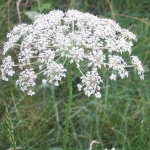| Drug Interactions: |
| Taking wild carrot with these drugs may increase skin sensitivity to sunlight: |
| Bumetanide, (Bumex, Burinex) |
Celecoxib, (Celebrex) |
Ciprofloxacin, (Cipro, Ciloxan) |
Doxycycline, (Apo-Doxy, Vibramycin) |
| Enalapril, (Vasotec) |
Etodolac, (Lodine, Utradol) |
Fluphenazine, (Modecate, Prolixin) |
Fosinopril, (Monopril) |
| Furosemide, (Apo-Furosemide, Lasix) |
Gatifloxacin, (Tequin, Zymar) |
Hydrochlorothiazide, (Apo-Hydro, Microzide) |
Ibuprofen, (Advil, Motrin) |
| Indomethacin, (Indocin, Novo-Methacin) |
Ketoprofen, (Orudis, Rhodis) |
Ketorolac, (Acular, Toradol) |
Lansoprazole, (Prevacid) |
| Levofloxacin, (Levaquin, Quixin) |
Lisinopril, (Prinivil, Zestril) |
Loratadine, (Alavert, Claritin) |
Methotrexate, (Rheumatrex, Trexall) |
| Naproxen, (Aleve, Naprosyn) |
Nortriptyline, (Aventyl HCl, Pamelor) |
Ofloxacin, (Floxin, Ocuflox) |
Omeprazole, (Losec, Prilosec) |
| Phenytoin, (Dilantin, Phenytek) |
Piroxicam, (Feldene, Nu-Pirox) |
Prochlorperazine, (Compazine, Compro) |
Quinapril, (Accupril) |
| Risperidone, (Risperdal) |
Rofecoxib, (Vioxx) |
Tetracycline, (Novo-Tetra, Sumycin) |
| Taking wild carrot with these drugs may increase the risk of hypotension (excessively low blood pressure): |
| Acebutolol, (Novo-Acebutolol, Sectral) |
Acetazolamide, (Apo-Acetazolamide, Diamox Sequels) |
Amiloride, (Midamor) |
Amlodipine, (Norvasc) |
| Atenolol, (Apo-Atenol, Tenormin) |
Azosemide, (Diat) |
Benazepril, (Lotensin) |
Betaxolol, (Betoptic S, Kerlone) |
| Bisoprolol, (Monocor, Zebeta) |
Bumetanide, (Bumex, Burinex) |
Candesartan, (Atacand) |
Captopril, (Capoten, Novo-Captopril) |
| Carteolol, (Cartrol, Ocupress) |
Carvedilol, (Coreg) |
Chlorothiazide, (Diuril) |
Chlorthalidone, (Apo-Chlorthalidone, Thalitone) |
| Clonidine, (Catapres, Duraclon) |
Diazoxide, (Hyperstat, Proglycem) |
Diltiazem, (Cardizem, Tiazac) |
Doxazosin, (Alti-Doxazosin, Cardura) |
| Eplerenone, (Inspra) |
Eprosartan, (Teveten) |
Esmolol, (Brevibloc) |
Ethacrynic Acid, (Edecrin) |
| Etozolin, (Elkapin) |
Felodipine, (Plendil, Renedil) |
Fenoldopam, (Corlopam) |
Fosinopril, (Monopril) |
| Furosemide, (Apo-Furosemide, Lasix) |
Guanabenz, (Wytensin) |
Guanadrel, (Hylorel) |
Guanfacine, (Tenex) |
| Hydralazine, (Apresoline, Novo-Hylazin) |
Hydrochlorothiazide, (Apo-Hydro, Microzide) |
Hydrochlorothiazide and Triamterene, (Dyazide, Maxzide) |
Hydroflumethiazide, (Diucardin, Saluron) |
| Indapamide, (Lozol, Nu-Indapamide) |
Irbesartan, (Avapro) |
Isradipine, (DynaCirc) |
Labetalol, (Normodyne, Trandate) |
| Lisinopril, (Prinivil, Zestril) |
Losartan, (Cozaar) |
Mannitol, (Osmitrol, Resectisol) |
Mecamylamine, (Inversine) |
| Mefruside, (Baycaron) |
Methazolamide, (Apo-Methazolamide, Neptazane) |
Methyclothiazide, (Aquatensen, Enduron) |
Methyldopa, (Apo-Methyldopa, Nu-Medopa) |
| Metolazone, (Mykrox, Zaroxolyn) |
Metoprolol, (Betaloc, Lopressor) |
Minoxidil, (Loniten, Rogaine) |
Moexipril, (Univasc) |
| Nadolol, (Apo-Nadol, Corgard) |
Nicardipine, (Cardene) |
Nifedipine, (Adalat CC, Procardia) |
Nisoldipine, (Sular) |
| Nitroglycerin, (Minitran, Nitro-Dur) |
Nitroprusside, (Nipride, Nitropress) |
Olmesartan, (Benicar) |
Olmesartan and Hydrochlorothiazide, (Benicar HCT) |
| Oxprenolol, (Slow-Trasicor, Trasicor) |
Perindopril Erbumine, (Aceon, Coversyl) |
Phenoxybenzamine, (Dibenzyline) |
Phentolamine, (Regitine, Rogitine) |
| Pindolol, (Apo-Pindol, Novo-Pindol) |
Polythiazide, (Renese) |
Prazosin, (Minipress, Nu-Prazo) |
Propranolol, (Inderal, InnoPran XL) |
| Quinapril, (Accupril) |
Ramipril, (Altace) |
Reserpine, (Reserpine) |
Spironolactone, (Aldactone, Novo-Spiroton) |
| Telmisartan, (Micardis) |
Terazosin, (Alti-Terazosin, Hytrin) |
Timolol, (Betimol, Timoptic) |
Torsemide, (Demadex) |
| Trandolapril, (Mavik) |
Triamterene, (Dyrenium) |
Trichlormethiazide, (Metatensin, Naqua) |
Urea, (Amino-Cerv, UltraMide) |
| Valsartan, (Diovan) |
Verapamil, (Calan, Isoptin SR) |
Xipamide, (Diurexan, Lumitens) |
| Taking wild carrot with these drugs may increase the risk of excessive sedation and mental depression and impairment: |
| Acetaminophen and Codeine, (Capital and Codeine, Tylenol with Codeine) |
Alfentanil, (Alfenta) |
Alprazolam, (Apo-Alpraz, Xanax) |
Amobarbital, (Amytal) |
Amobarbital and Secobarbital, (Tuinal) |
Aspirin and Codeine, (Coryphen Codeine) |
| Belladonna and Opium, (B&O Supprettes) |
Bromazepam, (Apo-Bromazepam, Gen-Bromazepam) |
Brotizolam, (Lendorm, Sintonal) |
Buprenorphine, (Buprenex, Subutex) |
Buprenorphine and Naloxone, (Suboxone) |
Butabarbital, (Butisol Sodium) |
| Butalbital, Acetaminophen, and Caffeine, (Esgic, Fioricet) |
Butalbital, Aspirin, and Caffeine, (Fiorinal) |
Butorphanol, (Apo-Butorphanol, Stadol) |
Chloral Hydrate, (Aquachloral Supprettes, Somnote) |
Chlordiazepoxide, (Apo-Chlordiazepoxide, Librium) |
Clobazam, (Alti-Clobazam, Frisium) |
| Clonazepam, (Klonopin, Rivotril) |
Clorazepate, (Tranxene, T-Tab) |
Codeine, (Codeine Contin) |
Dexmedetomidine, (Precedex) |
Diazepam, (Apo-Diazepam, Valium) |
Dihydrocodeine, Aspirin, and Caffeine, (Synalgos-DC) |
| Diphenhydramine, (Benadryl Allergy, Nytol) |
Estazolam, (ProSom) |
Fentanyl, (Actiq, Duragesic) |
Flurazepam, (Apo-Flurazepam, Dalmane) |
Glutethimide, (Glutethimide) |
Haloperidol, (Haldol, Novo-Peridol) |
| Hydrocodone and Acetaminophen, (Vicodin, Zydone) |
Hydrocodone and Aspirin, (Damason-P) |
Hydrocodone and Ibuprofen, (Vicoprofen) |
Hydromorphone, (Dilaudid, PMS-Hydromorphone) |
Hydroxyzine, (Atarax, Vistaril) |
Levomethadyl Acetate Hydrochloride, (Levomethadyl Acetate Hydrochloride) |
| Levorphanol, (LevoDromoran) |
Loprazolam, (Dormonoct, Havlane) |
Lorazepam, (Ativan, Nu-Loraz) |
Meperidine, (Demerol, Meperitab) |
Meperidine and Promethazine, (Meperidine and Promethazine) |
Mephobarbital, (Mebaral) |
| Methadone, (Dolophine, Methadose) |
Methohexital, (Brevital, Brevital Sodium) |
Midazolam, (Apo-Midazolam, Versed) |
Morphine Sulfate, (Kadian, MS Contin) |
Nalbuphine, (Nubain) |
Opium Tincture, (Opium Tincture) |
| Oxycodone, (OxyContin, Roxicodone) |
Oxycodone and Acetaminophen, (Endocet, Percocet) |
Oxycodone and Aspirin, (Endodan, Percodan) |
Oxymorphone, (Numorphan) |
Paregoric, (Paregoric) |
Pentazocine, (Talwin) |
| Pentobarbital, (Nebutal) |
Phenobarbital, (Luminal Sodium, PMS-Phenobarbital) |
Phenoperidine, (Phenoperidine) |
Prazepam, (Prazepam) |
Primidone, (Apo-Primidone, Mysoline) |
Promethazine, (Phenergan) |
| Propofol, (Diprivan) |
Propoxyphene, (Darvon, Darvon-N) |
Propoxyphene and Acetaminophen, (Darvocet-N 50, Darvocet-N 100) |
Propoxyphene, Aspirin, and Caffeine, (Darvon Compound) |
Quazepam, (Doral) |
Remifentanil, (Ultiva) |
| Secobarbital, (Seconal) |
Sodium Oxybate, (Xyrem) |
Sufentanil, (Sufenta) |
S-Zopiclone, (Lunesta) |
Temazepam, (Novo-Temazepam, Restoril) |
Tetrazepam, (Mobiforton, Musapam) |
| Thiopental, (Pentothal) |
Triazolam, (Apo-Triazo, Halcion) |
Zaleplon, (Sonata, Stamoc) |
Zolpidem, (Ambien) |
Zopiclone, (Alti-Zopiclone, Gen-Zopiclone) |
| Taking wild carrot with these drugs may increase the risk of cardiac glycoside toxicity: |
| Digitalis, (Digitek, Lanoxin) |
|

